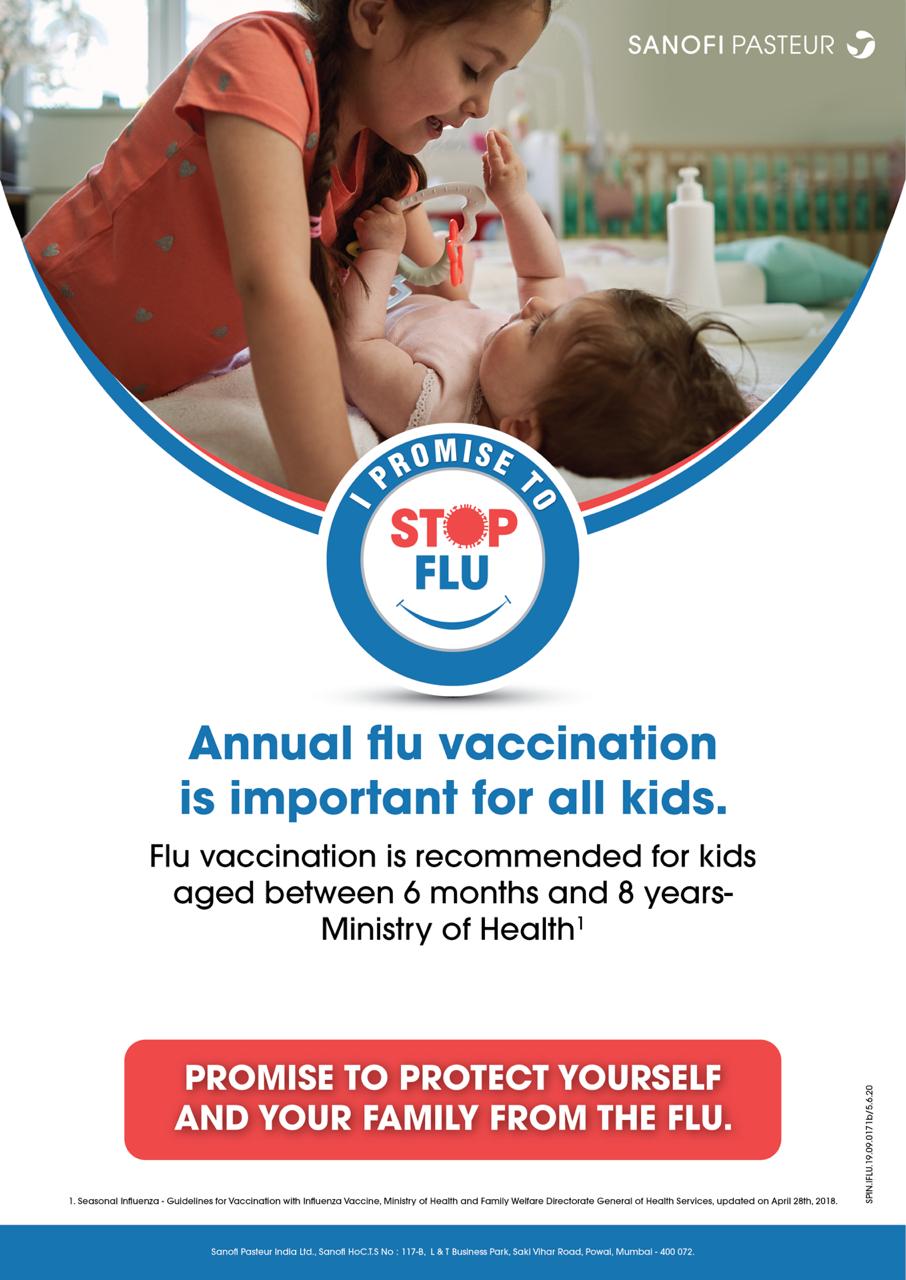At 7 months of age babies of Vadodara need to be given the second dose of flu vaccine. Influenza vaccine is given 2 doses, 1 month apart in the first year of life.
The vaccine recommended at this age is: INFLUENZA VACCINE
This vaccine is not covered in the Government schedule.
When Second Flu Shots Are Needed for Kids?
If your child is getting the seasonal flu shot for the first time, you can expect that they will also need a second shot a month later. This probably wasn’t the standard when you were a kid, but it has been recommended since 2009.
The Advisory Committee on Immunization Practices (part of the U.S. Centers for Disease Control and Prevention) recommends that all children 6 months old through 8 years old should get two doses of flu vaccine the first year that they are vaccinated against the flu. If your child had their first flu shot last year but only got a single shot, then this year, they should get a flu shot and a booster shot.
How the Second Flu Shot Works?
The second flu shot is a booster dose to improve the effectiveness of the flu vaccine in children. The second dose is given at least 28 days after the first dose. That first dose stimulates the child’s immune system, but it may not be enough to produce the level of antibodies needed for protection from the flu.
The second dose results in the child’s immune system producing enough antibodies so they will be able to fight off influenza when exposed. If your child didn’t receive the second dose, they likely have some protection against the flu, but it may not be enough.
So are they necessary? Let’s go through the problems with the disease and then decide:
INFLUENZA VACCINE


Seasonal influenza is an acute respiratory infection caused by influenza viruses that circulate in all parts of the world.
The pathogen
There are 4 types of seasonal influenza viruses, types A, B, C, and D. Influenza A and B viruses circulate and cause seasonal epidemics of disease.
- Influenza A viruses are further classified into subtypes according to the combinations of the hemagglutinin (HA) and the neuraminidase (NA), the proteins on the surface of the virus. Currently circulating in humans are subtype A(H1N1) and A(H3N2) influenza viruses. The A(H1N1) is also written as A(H1N1)pdm09 as it caused the pandemic in 2009 and subsequently replaced the seasonal influenza A(H1N1) virus which had circulated prior to 2009. Only influenza-type A viruses are known to have caused pandemics.
- Influenza B viruses are not classified into subtypes, but can be broken down into lineages. Currently circulating influenza type B viruses belong to either B/Yamagata or B/Victoria lineage.
- Influenza C virus is detected less frequently and usually causes mild infections, thus does not present public health importance.
- Influenza D viruses primarily affect cattle and are not known to infect or cause illness in people.
Signs and symptoms of Flu in Vadodara
Seasonal influenza is characterized by a sudden onset of fever, cough (usually dry), headache, muscle and joint pain, severe malaise (feeling unwell), sore throat, and a runny nose. The cough can be severe and can last 2 or more weeks. Most people recover from fever and other symptoms within a week without requiring medical attention. But influenza can cause severe illness or death, especially in people at high risk (see below).
Illnesses range from mild to severe and even death.
Hospitalization and death occur mainly among high risk groups.
Worldwide, these annual epidemics are estimated to result in about 3 to 5 million cases of severe illness, and about 290 000 to 650 000 respiratory deaths.
In industrialized countries, most deaths associated with influenza occur among people aged 65 or older.
Epidemics can result in high levels of worker/school absenteeism and productivity losses.
Clinics and hospitals can be overwhelmed during peak illness periods.
The effects of seasonal influenza epidemics in developing countries are not fully known, but research estimates that 99% of deaths in children under 5 years of age with influenza-related lower respiratory tract infections are found in developing countries.
Whom does Flu affect more in Vadodara
All age groups can be affected but there are groups that are more at risk than others.
People at greater risk of severe disease or complications when infected are:
- pregnant women,
- children under 59 months,
- the elderly,
- individuals with chronic medical conditions (such as chronic cardiac, pulmonary, renal, metabolic, neurodevelopmental, liver, or hematologic diseases) and
- individuals with immunosuppressive conditions (such as HIV/AIDS, receiving chemotherapy or steroids, or malignancy).
- Healthcare workers are at high risk of acquiring influenza virus infection due to increased exposure to the patients and the risk of further spread, particularly to vulnerable individuals.
In terms of transmission, seasonal influenza spreads easily, with the rapid transmission in crowded areas including schools and nursing homes. When an infected person coughs or sneezes, droplets containing viruses (infectious droplets) are dispersed into the air and can spread up to one meter, and infect persons in close proximity who breathe these droplets in. The virus can also be spread by hands contaminated with influenza viruses. To prevent transmission, people should cover their mouth and nose with a tissue when coughing, and wash their hands regularly.
In temperate climates, seasonal epidemics occur mainly during winter, while in tropical regions, influenza may occur throughout the year, causing outbreaks more irregularly.
The time from infection to illness, known as the incubation period, is about 2 days but ranges from one to four days.
Flu Vaccine Schedule for Vadodara babies
It is an yearly vaccine
Child vaccination schedule: 2 doses in the first year ie 6 months and 7 months of age. Followed by an annual dose. The best month to get vaccinated is May or June (before the start of the academic year)
So, don’t miss the second dose of flu vaccine for your child, and know more by consulting your Pediatrician!!
